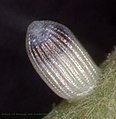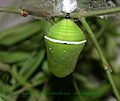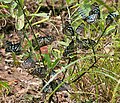Tirumala septentrionis
| Dark blue tiger | |
|---|---|

| |
| Upperside | |

| |
| Underside | |
| Scientific classification | |
| Kingdom: | |
| Phylum: | |
| Class: | |
| Order: | |
| Family: | |
| Genus: | |
| Species: | T. septentrionis
|
| Binomial name | |
| Tirumala septentrionis (Butler, 1874)
| |
Tirumala septentrionis (dark blue tiger) is a Danaid butterfly found in the Indian Subcontinent and Southeast Asia.
Description
Closely resembles Tirumala limniace, Cramer, but is always sufficiently distinct to be easily recognized, even on the wing. From T. limniace it differs on the upperside in the ground colour being darker and the semihyaline markings narrower, more distinct, and of a bluer tint, In the forewing, in interspace 1 the two streaks are narrower, never coalescent, the upper one forming an oval detached spot; the short streaks above vein 5 are outwardly never truncate, always acute. In the hindwing the two streaks if the discoidal cell united at base are wide apart at their apices, the lower one never formed into a hook. On the underside this species is generally darker, the apex of the forewing and the whole of the ground colour of the hindwing not being of the conspicuous golden brown that they are in Tirumala limniace.[1]
Expanse: 80–115 mm.
Distribution
The Himalayas from Simla to Sikhim, into Assam, Myanmar, and Southeast Asia; Orissa; W.B, southern India, the Western Ghats and Nilgiris; Sri Lanka.
Habits
This species is one of the predominant species (78%) during the migratory season in southern India during which many species migrate. Both males and females appear to migrate in equal numbers.[2]
Life cycle
Caterpillar is similar to that of T. limniace (see Journal of the Bombay Natural History Society x, 1896, p. 240). It is said by MacKinnon and de Niceville to feed on Vallaris dichotoma (Jour. Bomb. N. H. Soc. xi, 1807, p. 212).[1] Other species include Cosmostigma racemosa,[3] Heterostemma brownii and Cocculus spp.[4]
-
Egg
-
Caterpillar
-
Pupa
-
Adult
References
- ^ a b Bingham, C.T. (1905). The Fauna of British India, Including Ceylon and Burma Butterflies. Vol. 1 (1st ed.). London: Taylor and Francis, Ltd.
- ^ Kunte, K. 2005. Species composition, sex-ratios and movement patterns in Danaine butterfly migrations in southern India. Journ. Bombay Nat. Hist. Soc. 102(3):280-286
- ^ Nair, P. V. 2005. Cosmostigma racemosa, a new host plant record of the Dark Blue Tiger Butterfly Tirumala septentrionis from Kerala. Journal of the Bombay Natural History Society. 102(3):354
- ^ Gaden S. Robinson, Phillip R. Ackery, Ian J. Kitching, George W. Beccaloni and Luis M. Hernández HOSTS - A Database of the World's Lepidopteran Hostplants [1] Accessed October 2006
Gallery
-
Blue Tigers Tirumala limniace & Dark Blue Tigers Tirumala septentrionis on Crotalaria retusa (Rattleweed) at Talakona forest, in Chittoor District of Andhra Pradesh, India
-
Blue Tigers Tirumala limniace & Dark Blue Tigers Tirumala septentrionis on Crotalaria retusa (Rattleweed) at Talakona forest, in Chittoor District of Andhra Pradesh, India









